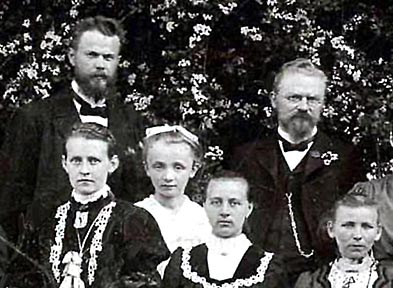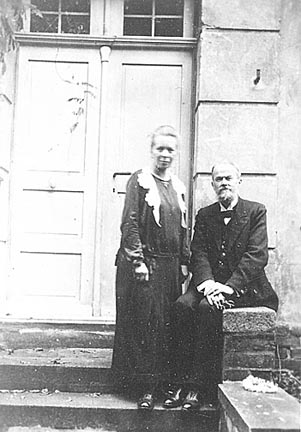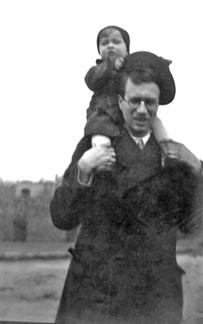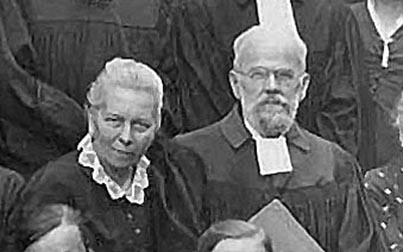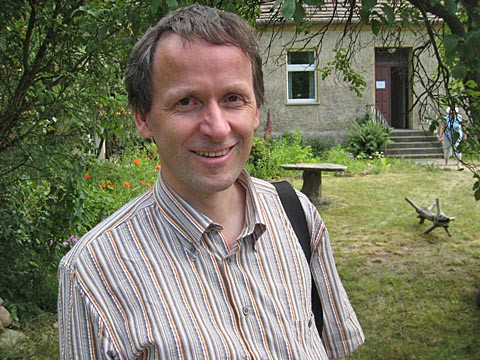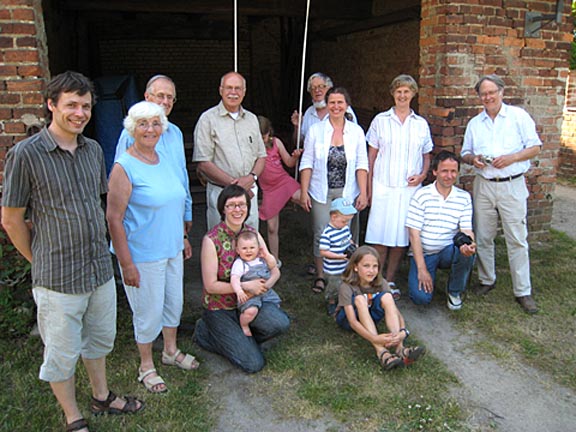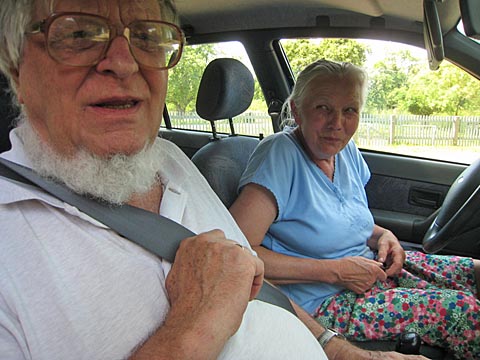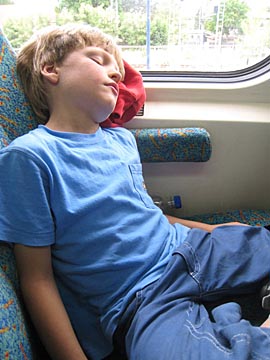Sacro 2008
One-Hundred-and-Eight
Years
Remembering Werner Gross
as Pastor in Sacro and
Patriarch of Our Family

Werner Siegfried Gross
When
I accepted Peter Schmidt's 2008 invitation to celebrate
grandfather Werner Gross' 140th birthday aniversary at his former
parsonage in Sacro, I didn't realise that we were about to enter
an enchanted world which had lain in limbo for over a
century.
Sacro is the small village in the Lausitz, Germany
where Grandfather Werner Gross, the white-bearded family patriarch
and nearest relative of God, had tended a recalcitrant flock of
half-heathen Wenden and Sorben for over 36 years as their pastor.
Between three and five I had visited his parsonage 2 or 3 times
before he retired to Frankfurt/Oder in 1936. Mythical memories -
some of my earliest: three live cranes fenced-in behind a huge
barn, the Landau of his predecessor, a frightening painting of a
blood-covered Christ, the rambling parsonage, and games played
with my "Bolivian" cousin Peter Schmidt.
This had
been in 1934 and 1936, 70 years ago!
Thanks to Cornelius'
enthusiasm, who offered to bring Ulysse along, the youngest scion
of the Gross line and the great-great-grandson of Werner Gross, I
accepted. The following pages try to recapture this entirely
unexpected, magical experience, suspended in time and space.
It
all began in 1900 with the wedding of Werner Gross and Margarete
Handtmann in Bernstadt, Schlesien which for unknown reasons is
known as the
"Japanische Hochzeit"

On 20 May 1900 Werner Gross married Margarete Liane Ottilie Handtmann in Bernstadt, Silesia (now Bierutow, Poland)
The photo shows the Inner Circle of the Handtmann family in Bernstadt: The groom, Werner Gross, tilting his head in resignation and his bride, Margarethe Handtmann, staring at the photographer as if she was going to kill him. The name of the Buddha behind them I don't know. Prossibly it is Agnes Kiepert, a nice of Liane Kiepert-Handtmann, Werner's mother-in-law on his left. Liane was the daughter of the famous cartographer and professor Heinrich Kiepert, after whom the Department of Geography at Berlin University is still named today. Liane's husband Paul Handtmann, the father of the bride and the host of this wedding sits to her left (his face is blurred in the photographic original). He was the director of the Bernstadt sugar factory, the only rich person in our family. Having lost everything in the Inflation of 1923, he would end his life as a pauper, in Sacro at his son-in-law's parsimonious parsonage in 1927.
To the far right of the bride sits Werner's mother, Elisabeth Thilo-Gross. She had inherited her beauty fom her father Emil Thilo, and her son's good looks must be attributed to the same source. The two interesting ladies in the second row between Elisabeth Gross and my grandmother are another Kiepert sister, Gertrud and - in the opinion of my Schmidt cousins - Gertrud Langerhans, the daughter of the physician Paul Langerhans (died 1887), a family friend who discovered the Langerhans' Islets in the pancreas (insulin),
Elisabeth Thilo-Gross had been a widow for 10 years. Julius Gross. Werner's father, the founder and director of the Bürgerschule in Görlitz, had died early in 1890 from pneumonia and emphysema. Money was short. Werner's older brother Konrad accepted a good position at the Imperial Botanical Gardens in St Petersburg, Russia. Werner had decided to study Protestant theology, because the church had offered to pay for part of his education.
In his “Memoirs” (edited by Hartmut Schmidt) grandfather Werner Gross describes how he had preached a couple of sermons in place of his uncle Richard Reimann, who was pastor in Sacro. This eventually would earn him uncle Richard's position in Sacro after Reimann retired in 1899. A letter from his father-in-law Paul Handtmann shows that only this steady position persuaded Handtmann to cede his daughter Margarethe's hand to Werner!
This is the only extant photo of my grandfather in his younger years. Throughout his life grandfather Gross remained a most imposing, good-looking man. By contrast grandmother always looked like a witch casting an evil eye on the photographer. She was not a happy person, but according to her letters to my parents she was not as evil as she looks on almost all photographs.
|
|
|
|
Werner Gross and sexton Benditz, who with his wife was Werners nemesis for twenty-five years. |
Grossmutter with Käthe on her lap and Ulrich, my father below (1905). |
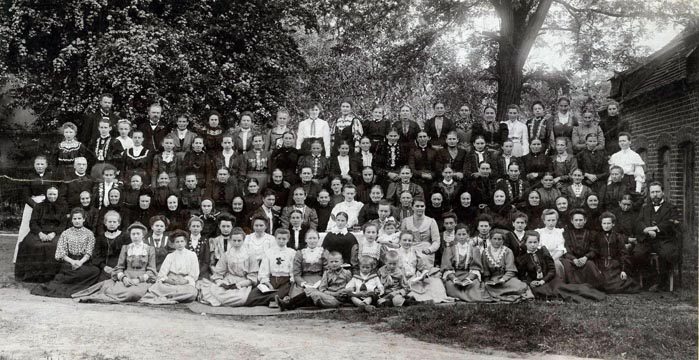
Both
of the above pictures I cut from this 1905 group photo of
grandmother's "Frauen- und Jungfrauen Verein" which she
had founded with the gracious support of Empress Auguste Viktoria
(Kaiser Wilhelm's wife) in 1904. (Photo Sacro church archives)
In the same year (1905) Werner's mother Elisabeth
Thilo-Gross died at his parsonage in Sacro.
|
|
|
An old photo of the church in Sacro and its interior (Photos Sacro church archives)

In 1916 during the First World War two of the three bells of the church had to be taken down and were converted to gun metal. Grandfather in the center. One of the first photos my father took with his new Kodak camera. (Photo Sacro church archives)
Visits to Sakro
1934-36
Between 1934 and 1936 my father took me 2 or 3 times to Sacro. The following rare photos came down to me from the Schmidts. Most of the pictures were taken by my father. We lost all of our prints in the 1946 exodus from Silesia.
|
|
1934, Sakro, Grandfather and Grandmother Gross at the rear entrance to their parsonage.
|
|
On my first visit in 1934 father carried me all the way from Forst to Sacro. One of my earliest memories..
|
1936, Sakro, Peter Schmidt and I in the defunct Landau of Uncle Richard Reimer, Grandfather's predecessor, a wonderful toy as you can see. But the object of my fascination was hidden behind the carriage: a huge painting of a frightfully bleeding, thorn-crowned Christ in a dusty frame, which I can still see before my eyes. |
1936, Sakro, Busom Friends, Peter and I in front of the bible-school where Grandmother taught the snut-nosed village children the singing of religious hymns.... |
|
1936, Sakro, Grandmother tried uncuccessfully to control her two independent grandsons. |
1936, Sakro, Peter and Rolf scrambling into the hay in the old barn, which has since been torn down. |
|
1936, Sakro, later Jochen Schmidt, Peter's brother joined us for a while. |
1936, Sakro, this is Gertrude Schneider from the village, one of my earliest girlfriends! |

In 1935, father had become the proud owner of a three-cylinder, two-cycle DKW-convertible, in which he drove Mother and me to Sakro. - In March 2008 Peter Schmidt brought me a thick packet of my father's correspondence with his parents. A long back and forth correspondence between gandfather and my father shows that the car had been a present from grandfather Gross... This is the farewell scene: Grandmother carrying me !!! Grandfather in his usual suit crying for the cleaners. My mother in an unusually fashionable hat and two village girls who had played with me and had come to see us off.
|
1936, Sacro, shortly before the Grandparents retired and moved to Frankfurt/Oder, Here they are talking to visiting relatives or friends. (Photo Sacro church archives)
|
|
1936, Sacro, the same photo enlarged
|
|
In 1937 they returned to Sacro to celebrate the anniversary of Grandmother's Frauenhilfe (Photo Sacro church archives)
|
|
The Grandparents from the above group photo. |
The
Great Family Reunion on
Grandfather's 140th Birthday
June 2008
They
all came: my Schmidt cousins Peter, Hartmut and Jochen and his son
Rolf, Friedemann, Peter's son, Barbara, Hartmut's daughter and
some of their wives, foremost Friedemann's wife Bettina, who
impressed me much. They in turn brought their children, perfect
playmates for Ulysse.
I had last seen my cousins together
in Zweilinden in 1943 and knew only Peter's wife Anneli and barely
the names of the others. A great, relaxed "hippie"
happening began which culminated in a most secular meeting with
the people from the parish on Monday evening in grandfathers
church.
This wonderful reunion would not have been possible
without the tireless work of fatherly Herr Natusch, who had made
all arrangements and picked us up at the station. Pastor Bodo
Trummer came on Saturday and Sunday between baptisms and sermons.
This most uncoventional, delightfully wild-looking man in his
forties, became my special friend. They were backed by a troupe of
parish women, who lugged food for us all into the kitchen and
prepared breakfast and a huge mountain of "belegte Brote"
(sandwiches German-style) and cakes for supper on Monday night.
|
From
the outside Grandfather's parsonage had changed little in the
intervening 70 years. A strange feeling - where Ulysse and
Lovis now play is the spot where father's DKW had stood when
we said goodbey to the grandparents in 1936. Grandmother's
Gemeindehaus and the old barn are gone. But the trees are
there, and someone has planted a garden of well-remembered
flowers.
|
|
I sat on the stairs on that quiet morning and watched the great-great-grandchildren of Werner Gross. Ulysse had found Friedemann Schmidt's children Anton and Lovis. Anton even spoke English!
|
|
Cornelius, Lovis and her mother Bettina.
|
|
Anton has brought a ball. He is 11, who needs a language to play soccer in Germany or Italy? Anton's little brother tottered between them.
|
|
Anton and his father Friedemann Schmidt, Peter's son. He and Bettina are practicing psychotherapists! Bettina seems to handle 4 children and a full job with competence.. (Cornelius photo)
|
|
A little later Lovis has overcome her shyness. I didn't hear how she and Ulysse - who speaks Italian, French and some English but no German - communicated. He learned quickly and soon said "Danke" when someone gave him something. (Cornelius photo)
|
|
Friedemann had brought two violins and Lovis and Anton played a piece for their grandparents. Ulysse watched spell bound. (Cornelius photo)
|
|
Barbara is Hartmut's daughter. She carried her daughter Friederike everywhere. Barbara went to Giebichenstein, where Marga Lattmann taught sculpture for a while. She works as a designer and painter of porcelain, a quiet, amiable woman. (Cornelius photo)
|
|
We slept in two dormitories under the eaves, one for the "men", another for the women.
|
|
I woke at 6:00 and watched Cornelius sleepily rise from under his blankets. Nobody spoke. Ulysse dressed himself. I had not seen them since October 2007.
|
|
For lunch Herr Natusch and Pastor Trummer took us to the "Gasthaus Sacro", half-way between Sacro and Forst: Peter und Anneli Schmidt, Jochen Schmidt, and Rolf. (Cornelius photo)
|
|
Across from us sat Friedemann's children and Ulysse. (Cornelius photo)
|
|
I had last seen my four cousins and their sister Sabine in Zweilinden in 1943! This is Peter the oldest who with his wife Anneli had visited us in Pacific Palisades in March 2008. He is the philosopher among the Schmidts. Remarkably he remembered many incidences from Zweilinden, and we were able to continue our 1943 discussion of the nature of the electron (sic!). (Cornelius photo)
|
|
And this is Jochen, the third cousin, with whom I had fought several bloody fistfights. He has become the most charming person."Oh", he said, "my brothers are "Kopfmenschen", I am a "Bauchmensch", that's why!" (Cornelius photo)
|
|
Jochen's son Rolf - named after me. He is the most likeable and affectionate among the Schmidtc hildren. Someday Barbara and I have to visit Jochen and his wife - who could not come - in Potsdam and meet Rolf again. (Cornelius photo)
|
|
Breakfast on Monday morning in the former dining room of our grandparents.
|
|
This is Pastor Bodo Trummer. Can you imagine our surprise? I took an immediate liking to him. "Most of my parishioners call me Bodo." He said, "you are welcome to do the same." (Cornelius photo)
|
|
Most kind Herr Natusch planning an excursion to visit the immense open lignite pits which a Swedish company mines and converts into electricity in loco. (Cornelius photo)
|
|
Among the many helpers Herr Natusch had from the municipal office in Forst was Herr Bauer, who took us on a hike to the Neisse river - since 1945 the Polish border. (Cornelius photo)
|
|
This poster, designed by Bodo Trummer and Herrn Natusch announced the long planned meeting in the church. (Cornelius photo)
|
|
The church anno 2008. The church itself is old (17th cent?). The old tower was replaced with the present one in 1894 before grandfather became pastor. (Cornelius photo)
|
|
They have taken the pews out of the church and repaced them with a loose arrangement of chairs. For the Monday meeting tables had been set up. A sizable number of parishioners had come and especially the older women followed Bodo Trummer's well researched, one-hour, illustrated talk on the life and activity of both Werner and Margarete Gross. Taken from grandfather's archives we learned a great deal. Several of the old photos above were culled from his talk. (Cornelius photo)
|
|
After Bodo's talk the women from the congration served a supper - seen here! Cornelius was mightily impressed. Afterwards I showed slides of my memories of Sacro and of our lives and those of my siblings. (Cornelius photo)
|
|
During the afternoon Eberhard Schmidt (center) and his sister Sabine Kiock (the tall woman in the white smock) had arrived. They are assembled before the dark shack where the Landau had once been garaged. Cornelius took the photo, and Ulysse must have been hiding with him.
|
|
On Tuesday morning one of the women from the village, seen here in her small car, drove first Peter and Annelie, then us to the railroad station in Forst. (Cornelius photo)
|
|
Ulysse and Nonno Rolf at the station. We separated at the Hauptbahnhof in Berlin, Cornelius and Ulysse stayed with friends and I with Valerie, the granddaughter of Friedemann Popp, once, in the 1930s, a close friend of my parents and our Kinder- and Hof-photographer in Glatz ... (Cornelius photo)
|
|
Totally
exhausted Ulysse fell asleep on the train. (Cornelius photo)
Rolf
Gross, Pacific Palisades, California, June 2008
|
